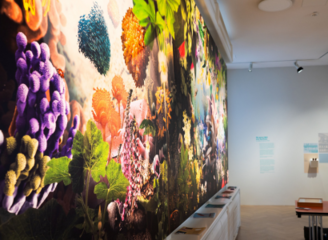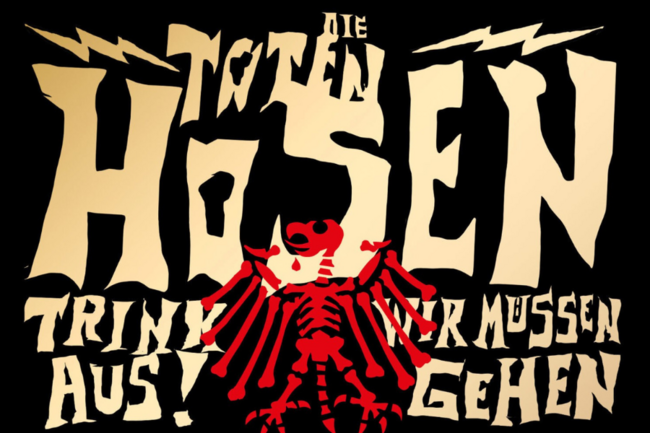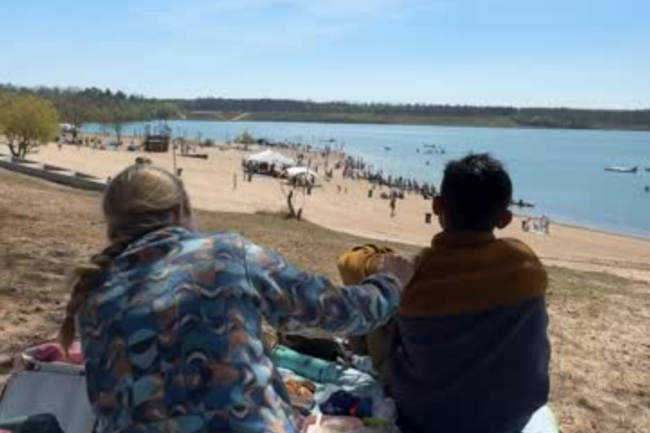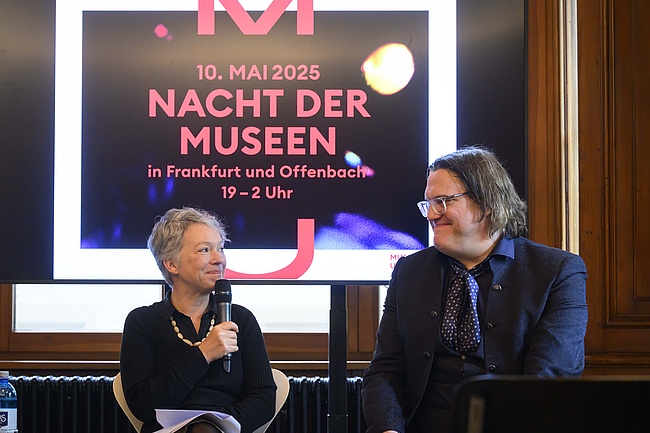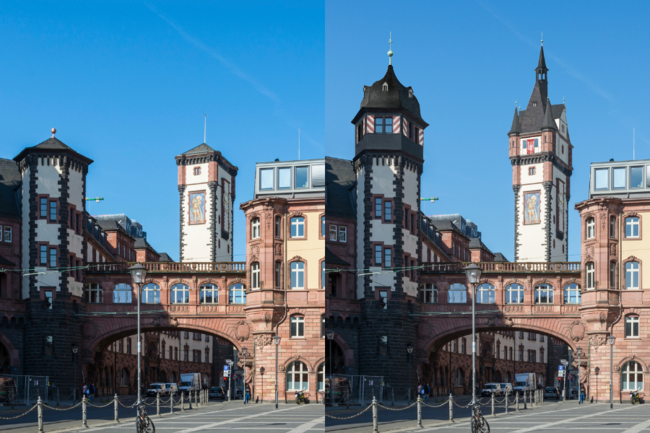Insect protection from millipede secretion, pregnancy tests using clawed frog substances, cancer therapy with the help of a sea sponge - what sounds amazing
really does exist: humans and animals use numerous natural substances for their health. From April 18, the new permanent exhibition "Nature + Medicine" on the 2nd floor of the Senckenberg Nature Museum Frankfurt will provide an insight into the astonishing variety of these active substances from the realm of fungi, lichens, bacteria, plants and animals and their medical benefits. A huge illuminated picture behind a reconstructed pharmacy façade brings together over 100 of these organisms, which are important for pharmacy, in an impressive collage. The history of medicine, global connections between health, biodiversity and the anthroposphere as well as the "medicine of animals" are also examined. The exhibition was made possible by the Else Kröner-Fresenius Foundation.
An extraordinary "jungle" shines through the doorway of the historic Hirsch Pharmacy in the center of the exhibition on a seven-meter-wide, ceiling-high picture: a fish warmth hovers above the pink flowers of a foxglove, right next to an oversized coliform bacterium and a tiny horse stands on the gigantic oyster mushroom. All of these and the numerous other organisms on display have one thing in common - they are used as medicinal substances in pharmacy and medicine. Visitors can find out exactly which active ingredients are hidden in the individual organisms and how they are used in medicines at a media terminal.
"The 'natural pharmacy' is severely threatened by the loss of biodiversity and the human and industrial exploitation of natural resources and knowledge. A new approach is urgently needed, especially with regard to global health knowledge. I am very pleased that, thanks to the support of the Else Kröner-Fresenius Foundation, we are now able to take a look at both the current and historical relationships between nature + medicine and highlight global perspectives," explains Prof. Dr. Brigitte Franzen, Director of the Nature Museum at the Senckenberg
Research Institute and Nature Museum Frankfurt.
The Director General of the Senckenberg Gesellschaft für Naturforschung, Prof. Dr. Klement Tockner, explains further: "The One Health approach is based on the understanding that the health of humans, animals and the environment are closely interwoven. However, prevention and interdisciplinary collaboration, especially between human medicine and environmental sciences, are essential to understand the interactions between biodiversity, climate change and human health and consequently to develop innovative strategies to protect nature and humans. We urgently need a paradigm shift towards nature-positive action and a holistic approach to protecting the environment and safeguarding our well-being that focuses on prevention and precaution."
The "False Medicine" exhibition area is all about endangered animals. The exhibits on display there, such as tiger skin and narwhal tooth, are examples of organisms that supposedly contain active ingredients and are therefore hunted or killed. "The most illegally traded animal worldwide is currently the pangolin. This and many other species are threatened by a lack of knowledge or
access to medicines," explains museum curator Dr. Thorolf Müller. The fact that early medical practices were also shaped by mythical, spiritual or philosophical ideas is highlighted in the "History of medicine" chapter. However, archaeological finds also prove that people were often right about natural remedies and that this knowledge is sometimes very old. In the first-aid kit of the 5000-year-old ice mummy "Ötzi"
, researchers found a tree fungus, the birch spore - its antibiotic and hemostatic effect has now been scientifically proven.
The façade that divides the exhibition space is also historical and is based on the Frankfurt Hirsch Pharmacy, one of the oldest pharmacies in the Main metropolis. It is the nucleus of the Fresenius Group and the charitable Else Kröner-Fresenius Foundation, which is a major sponsor of the exhibition project. "Our founder, Else
Kröner, built up a globally active healthcare group from the Hirsch Pharmacy in her impressive life's work. Her foster father, Dr. Eduard Fresenius, maintained a pharmacy garden for the extraction of raw materials for his naturopathic products, and today the Fresenius company produces medicines from natural substances. We want to draw attention to this development and the importance of natural substances in modern medicine for the general public, but especially for all those working in the health sector," explains Prof. Dr. Michael Madeja, Chairman of the Board of the Else Kröner-Fresenius Foundation.
It is not only humans, but also animals that use substances from nature to heal themselves: For example, some birds, such as the jay, take a bath in an anthill and use formic acid to protect their feathers from parasites such as mites, lice, bacteria or fungi. "The black lemur pursues the same goal when it nibbles on a millipede and spreads its secretion in its fur. The fact that the liquid also puts the half-monkey into a state of intoxication is a side effect that our museum preparator has captured convincingly in the
facial expression of the exhibit," explains museum curator Adela Kutschke. A wall projection with sound effects illustrates other stories of how animals heal themselves. Some animals still amaze natural scientists in biomedicine today with their superpowers: The microscopic tardigrade can reduce its metabolism through dehydration and thus survive the most adverse living conditions. Naked mole rats are small rodents that live underground in cave systems, live to a very old age, rarely suffer from diseases such as cancer and are insensitive to pain. Lifelike models of these and other animals from the zoological taxidermy workshops of the Frankfurt Research Institute and Nature Museum can be seen in the exhibition.
However, it is not only the potential for healing that lies dormant in nature. Infectious diseases, so-called zoonoses, can also be transmitted between animals and humans. "The likelihood of zoonoses occurring is increasing due to population growth, global trade, increasing mobility, climate change, wildlife markets, factory farming and the intrusion of humans into natural and semi-natural habitats," explains Tockner. Three large models of pathogens - the SARS-CoV-2 coronavirus, a plague bacterium
and a malaria pathogen - hang above a table in the exhibition, where visitors can find out about various zoonotic infectious diseases.
New permanent exhibition "Nature + Medicine" from April 18 at the Senckenberg Research Institute and Nature Museum Frankfurt, Senckenberganlage 25, 60325 Frankfurt am Main.
Admission: 12 euros, children and young people aged 6-17: 6 euros
Online tickets at: senckenberg.ticketfritz.de
Opening hours: Daily from 9 am to 5 pm, Wednesday until 8 pm, Saturday,
Sunday and public holidays until 6 pm.







